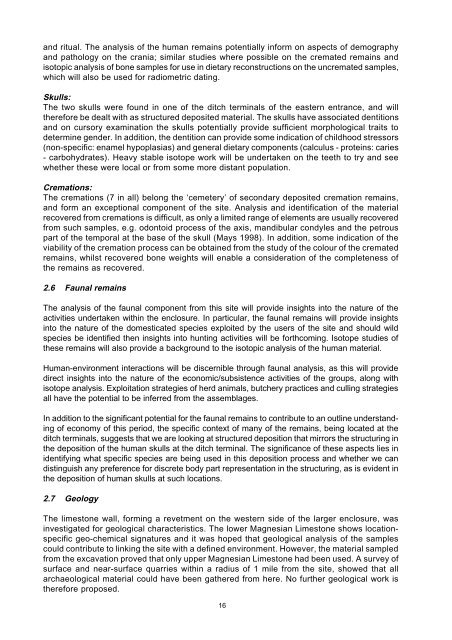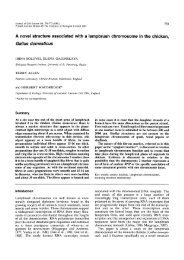Sutton Common Updated project design - University of Exeter
Sutton Common Updated project design - University of Exeter
Sutton Common Updated project design - University of Exeter
You also want an ePaper? Increase the reach of your titles
YUMPU automatically turns print PDFs into web optimized ePapers that Google loves.
and ritual. The analysis <strong>of</strong> the human remains potentially inform on aspects <strong>of</strong> demography<br />
and pathology on the crania; similar studies where possible on the cremated remains and<br />
isotopic analysis <strong>of</strong> bone samples for use in dietary reconstructions on the uncremated samples,<br />
which will also be used for radiometric dating.<br />
Skulls:<br />
The two skulls were found in one <strong>of</strong> the ditch terminals <strong>of</strong> the eastern entrance, and will<br />
therefore be dealt with as structured deposited material. The skulls have associated dentitions<br />
and on cursory examination the skulls potentially provide sufficient morphological traits to<br />
determine gender. In addition, the dentition can provide some indication <strong>of</strong> childhood stressors<br />
(non-specific: enamel hypoplasias) and general dietary components (calculus - proteins: caries<br />
- carbohydrates). Heavy stable isotope work will be undertaken on the teeth to try and see<br />
whether these were local or from some more distant population.<br />
Cremations:<br />
The cremations (7 in all) belong the ‘cemetery’ <strong>of</strong> secondary deposited cremation remains,<br />
and form an exceptional component <strong>of</strong> the site. Analysis and identification <strong>of</strong> the material<br />
recovered from cremations is difficult, as only a limited range <strong>of</strong> elements are usually recovered<br />
from such samples, e.g. odontoid process <strong>of</strong> the axis, mandibular condyles and the petrous<br />
part <strong>of</strong> the temporal at the base <strong>of</strong> the skull (Mays 1998). In addition, some indication <strong>of</strong> the<br />
viability <strong>of</strong> the cremation process can be obtained from the study <strong>of</strong> the colour <strong>of</strong> the cremated<br />
remains, whilst recovered bone weights will enable a consideration <strong>of</strong> the completeness <strong>of</strong><br />
the remains as recovered.<br />
2.6 Faunal remains<br />
The analysis <strong>of</strong> the faunal component from this site will provide insights into the nature <strong>of</strong> the<br />
activities undertaken within the enclosure. In particular, the faunal remains will provide insights<br />
into the nature <strong>of</strong> the domesticated species exploited by the users <strong>of</strong> the site and should wild<br />
species be identified then insights into hunting activities will be forthcoming. Isotope studies <strong>of</strong><br />
these remains will also provide a background to the isotopic analysis <strong>of</strong> the human material.<br />
Human-environment interactions will be discernible through faunal analysis, as this will provide<br />
direct insights into the nature <strong>of</strong> the economic/subsistence activities <strong>of</strong> the groups, along with<br />
isotope analysis. Exploitation strategies <strong>of</strong> herd animals, butchery practices and culling strategies<br />
all have the potential to be inferred from the assemblages.<br />
In addition to the significant potential for the faunal remains to contribute to an outline understanding<br />
<strong>of</strong> economy <strong>of</strong> this period, the specific context <strong>of</strong> many <strong>of</strong> the remains, being located at the<br />
ditch terminals, suggests that we are looking at structured deposition that mirrors the structuring in<br />
the deposition <strong>of</strong> the human skulls at the ditch terminal. The significance <strong>of</strong> these aspects lies in<br />
identifying what specific species are being used in this deposition process and whether we can<br />
distinguish any preference for discrete body part representation in the structuring, as is evident in<br />
the deposition <strong>of</strong> human skulls at such locations.<br />
2.7 Geology<br />
The limestone wall, forming a revetment on the western side <strong>of</strong> the larger enclosure, was<br />
investigated for geological characteristics. The lower Magnesian Limestone shows locationspecific<br />
geo-chemical signatures and it was hoped that geological analysis <strong>of</strong> the samples<br />
could contribute to linking the site with a defined environment. However, the material sampled<br />
from the excavation proved that only upper Magnesian Limestone had been used. A survey <strong>of</strong><br />
surface and near-surface quarries within a radius <strong>of</strong> 1 mile from the site, showed that all<br />
archaeological material could have been gathered from here. No further geological work is<br />
therefore proposed.<br />
16
















